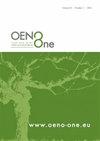Improved berry and wine quality of Vitis vinifera L. cv. Gewürztraminer grown in an arid climate using a Y-shaped training system
IF 2.2
3区 农林科学
Q3 FOOD SCIENCE & TECHNOLOGY
引用次数: 0
Abstract
Recent global climatic changes have highlighted viticulture in arid/semiarid regions as an increasingly relevant study model. Grapes in arid regions face excessive solar irradiance, leading to more than 50 °C berry surface temperatures in exposed berries. The resultant oxidative stress, sunburn necrosis, and browning consistently reduce berry quality. Adapting an adequate training system to the climate and cultivar is a simple and inexpensive method to control the radiation regime. This study compares the berry and wine characteristics and compositional components of desert-grown Vitis vinifera L. cv. Gewürztraminer, trained on either a Vertical Shoot Positioning (VSP) system or a Y-shaped training system (SAYM, Sistema di Allevamendo ad Ypsilon Integralmente Meccanizzabile), a method with a higher canopy light interception. The SAYM training reduced direct radiation and concomitant heat in the cluster zone and significantly alleviated oxidative stress in berries in the 2016/17 season. In addition, SAYM-grown berries were preferable in terms of quality and productivity. Correspondingly, a sensorial analysis rated SAYM wines higher than VSP wines in all categories. Photosynthetic pigment content in the berries' skin showed similarities between VSP and SAYM, and a volatile compound analysis of the wines by GC-MS revealed a higher ester content in the wines derived from SAYM vines, along with a higher content of compounds linked to Gewürztraminer wine typicity (varietal characteristics such as esters, terpenoids, and alcohols).利用 Y 型培训系统提高干旱气候条件下种植的葡萄品种琼瑶浆的浆果和葡萄酒质量
最近的全球气候变化突出表明,干旱/半干旱地区的葡萄栽培是一个日益相关的研究模型。干旱地区的葡萄面临过度的太阳辐照,导致暴露在阳光下的浆果表面温度超过 50 °C。由此产生的氧化应激、日灼坏死和褐变不断降低浆果的品质。根据气候和栽培品种调整适当的培训系统是控制辐射制度的一种简单而廉价的方法。本研究比较了在沙漠中种植的葡萄品种琼瑶浆的浆果和葡萄酒特征及组成成分,它们分别采用了垂直嫩枝定位系统(VSP)或 Y 型栽培系统(SAYM,Sistema di Allevamendo ad Ypsilon Integralmente Meccanizzabile)进行栽培,Y 型栽培系统具有更高的冠层截光能力。SAYM 栽培法减少了直接辐射和果穗区随之而来的热量,并显著减轻了 2016/17 榨季浆果的氧化应激。此外,SAYM 法种植的浆果在质量和产量方面更胜一筹。相应地,感官分析对 SAYM 葡萄酒的各项评分均高于 VSP 葡萄酒。浆果表皮中的光合色素含量显示出 VSP 和 SAYM 的相似性,通过 GC-MS 对葡萄酒进行的挥发性化合物分析表明,SAYM 葡萄园出产的葡萄酒中酯含量更高,与琼瑶浆葡萄酒类型相关的化合物含量也更高(如酯类、萜烯类和醇类等品种特征)。
本文章由计算机程序翻译,如有差异,请以英文原文为准。
求助全文
约1分钟内获得全文
求助全文
来源期刊

OENO One
Agricultural and Biological Sciences-Food Science
CiteScore
4.40
自引率
13.80%
发文量
85
审稿时长
13 weeks
期刊介绍:
OENO One is a peer-reviewed journal that publishes original research, reviews, mini-reviews, short communications, perspectives and spotlights in the areas of viticulture, grapevine physiology, genomics and genetics, oenology, winemaking technology and processes, wine chemistry and quality, analytical chemistry, microbiology, sensory and consumer sciences, safety and health. OENO One belongs to the International Viticulture and Enology Society - IVES, an academic association dedicated to viticulture and enology.
 求助内容:
求助内容: 应助结果提醒方式:
应助结果提醒方式:


